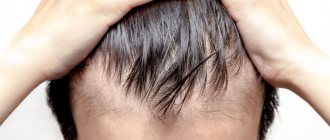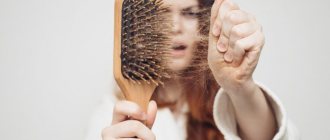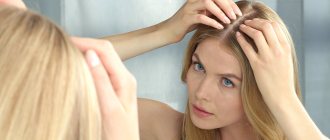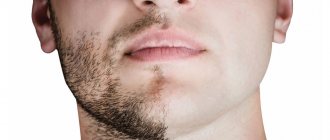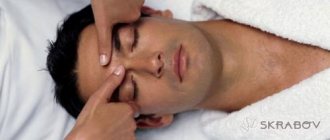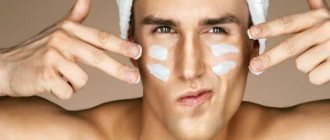Baldness is the scourge of modern men; according to statistics, every third man aged 25-35 years has this problem. In medicine, baldness is called alopecia; several of its forms are considered - androgenic, total, focal, cicatricial and diffuse alopecia in men. The latter option is not as common as androgenetic or focal alopecia, but still occurs among men of different ages.
Diffuse male pattern baldness is characterized by uniform hair loss without further recovery due to a violation of the biological program of hair development and growth. Various factors that require clinical study can lead to such a disorder. Only by knowing the reasons for the development of diffuse alopecia will a specialist be able to select the optimal treatment methods.
The main causes of the disease
Normally, each person loses about 50-150 hairs, but new hair gradually grows in place, preventing baldness. If the doctor has diagnosed diffuse alopecia, the number of hairs lost per day may exceed 1000, which is accompanied by aesthetic dissatisfaction and psychological discomfort. Only by knowing the provoking factors can the doctor determine methods of treatment.
Diffuse hair loss can occur due to various reasons, for example:
- psycho-emotional stress, which results in the production of aggressive hormones;
- hormonal imbalance, endocrine pathologies, dysfunction of the adrenal cortex, testicles, pituitary gland, thyroid gland;
- taking medications, for example, antibiotics, hormonal drugs, antidepressants, antipsychotics;
- extensive surgical interventions and severe injuries;
- infectious and inflammatory diseases;
- poor nutrition, abuse of unhealthy foods, deficiency of vitamins and microelements;
- poisoning with toxic substances;
- irradiation of the body.
In any case, baldness never occurs without serious reasons; most often, several disorders in the body, immune and hormonal imbalances contribute to this. Therefore, it is important to contact the clinic after the first manifestations of alopecia.
Diffuse hair loss: what is it?
Hair loss (alopecia) is a disease that occurs in 30% of people aged 20 to 50 years. The most common form is diffuse. With it, a person’s hair falls out intensively and evenly over the entire surface of the scalp. This disorder is more common in men and women, less common in children.
Pathology occurs due to several reasons:
- chronic diseases;
- prolonged stress;
- lack of vitamins in the body;
- hormonal imbalances;
- anemia (anemia due to iron deficiency);
- long-term use of anticonvulsants.
Surface of damaged hair
If you contact a specialist early, rapid hair restoration can occur.
If this disorder is neglected, the treatment will be lengthy. It is not recommended to treat hair loss on your own, because improper treatment can result in complete baldness.
Mechanism of disease development
Only a trichologist knows all the phases of hair growth and development, indicators of normality and deviations from them. In general, during hair growth there are 3 phases - anagen, catagen and telogen phase. If we consider the problem of diffuse alopecia, the patient has a disorder in one of the phases, it all depends on the individual characteristics of the body. Visually, this manifests itself in the form of pathological hair loss from the surface of the head.
Any internal failures, pathologies and diseases can lead to such a violation if there is a weakened immune system and an unbalanced diet. Hair follicles do not receive the proper amount of vitamins and valuable substances, the supply of blood and oxygen is disrupted, the duration of one or more phases of hair growth is shortened and suspended. As a result, in the last phase, the hairs simply begin to fall out.
Threat of relapse
Recurrence of symptoms of the disease is possible if the patient has been diagnosed with chronic diffuse alopecia. Relapse is also possible if the form is not treated or some of the doctor’s recommendations are ignored.
But even successful therapy and elimination of consequences does not guarantee the development of immunity against further relapses. If we are talking about female alopecia, after recovery you should forever give up hair coloring, curling, and blow-drying, as all this spoils the hair structure and makes it weaker.
In addition, to avoid recurrent baldness, the patient should change his diet to a healthy one, eliminate alcohol, quit smoking and be examined more often.
Diffuse alopecia is a disease whose cause is not always clear. This disease terrifies the female half of the population to a greater extent. It is impossible to go completely bald with it, but it is possible to lose the beauty and thickness of your hair forever. The problem can be avoided only after eliminating the causes affecting the condition, formation and growth of hair.
Classification
Diffuse alopecia can be classified into two types depending on the phase of hair growth at which it appears. Namely:
- Telogen effluvium alopecia – against the background of a pathological process in the body, alopecia develops gradually against the background of stress, hormonal disorders, deficiency of vitamins and microelements. The trichologist diagnoses the premature withdrawal of follicles into the resting phase, and accordingly, hair growth stops.
- Anagen diffuse alopecia – against the background of sharp aggressive factors (irradiation, toxic poisoning, intoxication), sudden hair loss occurs. Most often, such baldness is observed in cancer patients who have undergone chemotherapy.
Expert opinion
Elena Druzhnikova
Sexologist. Family relations expert. Family psychologist.
Despite the different types of diffuse alopecia, most often the trichologist draws up a similar set of therapeutic measures to cure baldness. Only this approach can restore normal hair growth, as well as prevent further worsening of alopecia.
Clinical manifestations
Based on the characteristic signs, the disease can be identified in a timely manner, in which case the treatment will be effective and not long-term. The first and main sign of diffuse alopecia is uniform hair loss everywhere on a man’s head. Hair will also become dull, weak and brittle. If diffuse alopecia is caused by serious diseases such as syphilis, thyroid dysfunction or allergic dermatitis, hair may fall out on the eyebrows and eyelashes.
Gradual hair loss can be detected in the parting area, and the bald spots will be round in shape. If we consider the telogen effluvium form of diffuse baldness, both acute and gradual onset are possible. Anagen effluvium is accompanied by complete hair loss within several weeks after aggressive exposure to provoking factors.
ethnoscience
What masks to use for diffuse alopecia? Folk remedies that you can prepare at home will help improve the condition of your hair (but not restore lost hair):
- Honey, heated in a water bath, is mixed with aloe juice, onion juice, burdock oil, and hot pepper tincture . The mask is applied to the head and wrapped warmly for 20 minutes. After this, you must thoroughly rinse off the composition. Use 2-3 times a week.
- A decoction of burdock root (2 tablespoons per 1 liter of water) is rubbed into the hair roots and left overnight. The procedure can be performed daily.
Read on our website about effective masks against hair loss using: oak bark, sea and table salt, garlic, yeast, burdock oil, herbal decoctions, hops.
Diagnosis of alopecia
First, the patient needs to see a therapist who will assess his general health. Next, you will need to consult a trichologist, endocrinologist, gastroenterologist, oncologist, urologist, infectious disease specialist to determine the causes of the development of diffuse alopecia. Laboratory studies involve several types of tests:
- biochemical and clinical blood test;
- blood test for hormones;
- checking blood sugar levels;
- allergy tests;
- ultrasound examination of the pelvic organs, peritoneum, thyroid gland;
- tests to detect parasites;
- immunogram to detect autoimmune disorders.
A separate consultation with a psychotherapist or psychologist is also carried out to identify any disturbances in the psycho-emotional background and correct such a condition.
Important! Restoration of hair growth after diffuse alopecia in a man occurs on average after 3-9 months of treatment, if the patient consults a doctor in a timely manner.
Basic methods of treating the disease
Therapeutic measures prescribed by a trichologist should be aimed primarily at neutralizing the provoking factors of alopecia. And only after they are eliminated, treatment will be aimed at restoring hair growth and scalp health. Only an integrated approach to drawing up a course of therapy guarantees a positive outcome, unless the patient consults a doctor too late.
Medication
Drug treatment for baldness is prescribed only by a medical specialist, since many drugs are sold strictly according to a prescription, and if used irrationally, cause side effects. Treatment of diffuse alopecia with drugs is as follows:
- taking medications that stimulate blood flow - Cosilon, Generalolon or Minoxidil;
- taking sedatives - Valerian, Persen, Peony tincture, etc.;
- taking vitamins and minerals to stimulate hair growth - Vitrum Beauty, Alphabet, ABC Spectrum, Selentsin, etc.
Cosmetic
The most common way to treat alopecia of various forms and stages in a beauty salon is mesotherapy. During the procedures, the doctor injects vitamins into the scalp to strengthen and grow hair, microelements, plant extracts, and amino acids. Vacuum and manual massage is also practiced to improve blood supply and nutrition of hair follicles.
Physiotherapy is an alternative treatment for diffuse alopecia. The doctor may prescribe massage procedures using a vibration helmet, darsonvalization, cryotherapy or electroporation. All of these methods perform one function - they accelerate local blood flow, due to which the hair roots and follicles receive adequate nutrition with oxygen and useful resources of the body.
Surgical
If conservative treatment of diffuse hair loss does not lead to restoration of hair growth, the doctor prescribes a radical method of treatment - surgery. The operation will last about 4-6 hours, during which hair is transplanted from the back of the head to the balding areas. The maximum effect after transplantation is observed after 3-4 months.
Proper care
Hair care is another way to restore hair growth and strengthen hair roots. It is extremely important for a man to choose the right shampoos and conditioners, taking into account his hair type and scalp characteristics. Pharmacies today offer a wide selection of medicinal cosmetics that stimulate hair growth. Any problems with hair, be it fragility, dryness or excessive oiliness, seborrhea and others, should be eliminated in a timely manner with the help of proper care.
Features of hair loss in pregnant women
During pregnancy, hormonal levels change. Estrogen has the strongest effect, as it stimulates hair growth and prevents hair loss. After childbirth, the body’s condition stabilizes, the amount of the hormone decreases. Hair begins to fall out rapidly because it lingers in the hair follicles for a long time.
The period of the most severe hair loss occurs in the 3-4th month after childbirth, and the alopecia itself lasts about a year. The constant stress of a young mother due to worries about the child, lack of help, and poor nutrition also affect the development of this disease.
To avoid alopecia, you need to follow the recommendations of trichologists:
- comb your hair carefully after washing your hair;
- use shampoo that contains zinc and silicon;
- take vitamins;
- eat more vegetables and fruits.
Prevention
Diffuse alopecia can be avoided with the help of preventive measures prescribed by experienced trichologists and dermatologists.
Do you take measures to maintain hair thickness?
Not really
Namely:
- timely treatment of any diseases in the body;
- annual preventive examination of the body in the clinic;
- balanced diet;
- taking vitamins during the off-season;
- active and mobile lifestyle;
- comprehensive hair care – shampoos, conditioners, masks;
- proper rest, sleep, avoidance of stress.
All men need to follow these simple rules, since due to the sensitivity of the hair roots to androgens, as well as their close proximity to the scalp, the risks of developing baldness threaten almost everyone.
